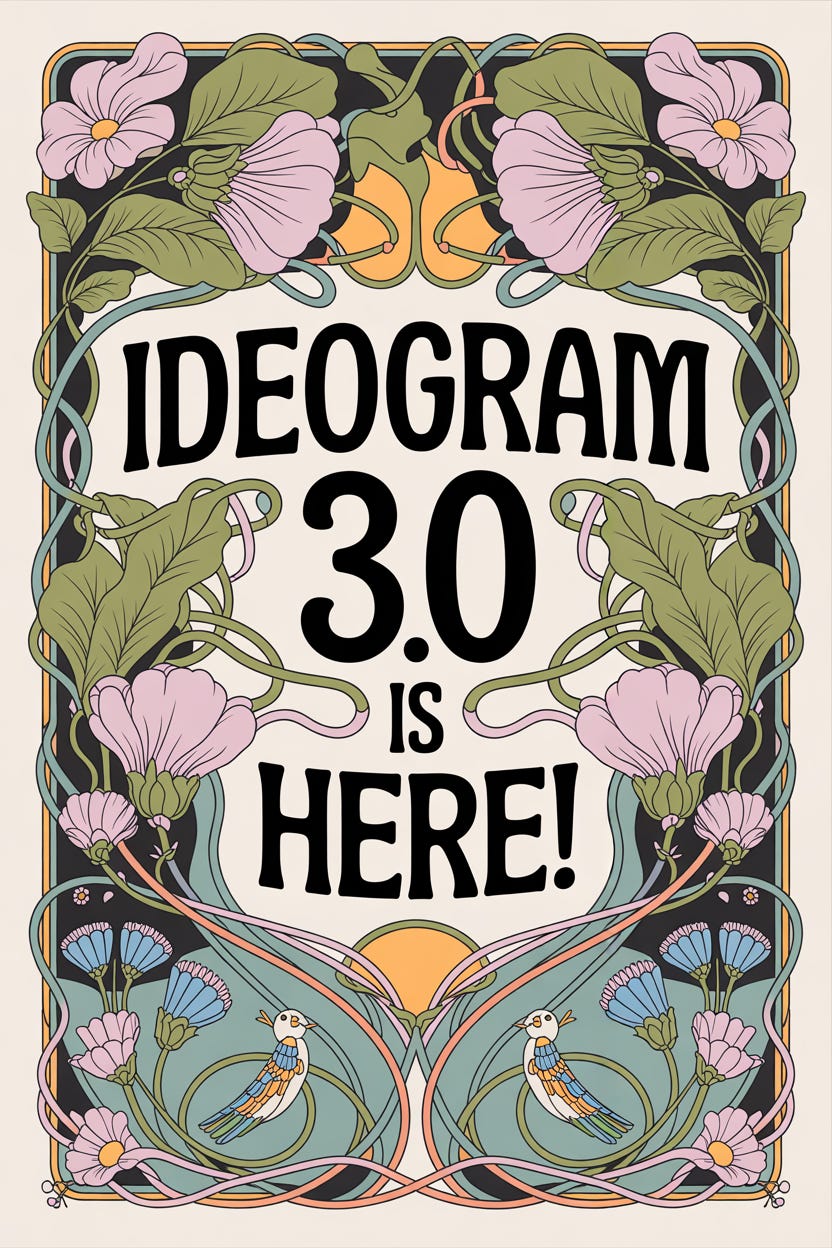Creativity AI #13: Weekly dose of AI updates
Midjourney Office Hours (2025-03-26), Ideogram 3.0, Revolution in Scientific Publishing, Gemini 2.5, Claude, OpenAI text-to-speech
Creativity AI is a new publication that brings together interesting articles and recent developments in the AI world related to creativity and productivity.
Midjourney Office Hours (2025-03-26)
Midjourney V7 is likely to be released next week!
There are still a few minor issues for the developers to address (for example, tweaking Style References and Moodboard for backward compatibility, Omni-reference) and optimizing the new model to make it faster.
According to David, 7/10 things now work, and the testers are pleased.
The V7 represents a bigger leap from V5 to V6.
At launch, V7 may not include all of the V6 features. Quality, remix, weird, multi-prompt, and negative prompts might not be available.
According to community feedback, text is currently not the main focus of V7. However, it can be included in the next V7.1 update.
The training for the video feature will begin in April, and the release date is unknown.
The 3D feature has a working demo now, but it is unclear when it will be available.
Ideogram 3.0
Ideogram released its latest version 3.0 today, which features improved image quality and realism, creative design, and style reference. Users can now upload up to three reference images to help guide the generated image style. Magic Fill and Extend will be upgraded to the new model very soon. However, the tile (seamless background) is not yet supported in 3.0 (duh!)
Here’re some images I created with Ideogram 3.0.
I'm impressed by its typographic capabilities. See these examples:
This is the prompt I used with Magic Prompt enabled. (Ideogram's Magic Prompt feature automatically enhances the user input prompt).
A very detailed art nouveau poster with typography art "Ideogram 3.0 is here!" with floral and animal decorative background

Perplexity
Perplexity has introduced its answer modes for better searches for travel, shopping, places, images, videos, and jobs. At the time of this writing it is not on its web yet.
A revolution in scientific publishing to unlock knowledge for all
It's pretty insane to know that 50% of all academic output is behind a paywall. It's no surprise that scientific research is largely limited to specialized institutions because the average Joe who aspires to be a "citizen scientist" must find ways to get around the paywall or pay the publishers just to get access to new scientific discoveries.
Why can't they make journal articles available to everyone for free? Basically, it's about money and who will pay for free access. In general, the average fee for publishing an open-access article is around $1,400. A journal issue typically contains multiple articles. Journal publishers rely on article processing and access fees, among other sources of revenue.
But what if the libraries in the world worked together to cover the fees and make the journal freely available to all? It's as if a group of friends splits the cost of watching the streaming service, rather than each paying for his or her own binge-watching.
That is exactly how the new publishing model known as "Subscribe to Open" (S2O) works, but on a much larger scale.
Here's how it works:
Libraries continue to pay their usual journal subscriptions.
If enough libraries subscribe, the journal will become open access to everyone, not just subscribers.
This process is repeated annually, ensuring that science remains accessible as long as libraries continue to participate.
Starting January 2026 (next year), BioOne, a leading nonprofit aggregator, has secured commitments from 71 titles from 54 global societies, museums, and research organizations to make S2O a reality. De Gruyter, another publisher, aims to convert 85% of its 320 subscription journals to open access by 2028.
You may be wondering whether people will read the journal if it is free to access? De Gruyter implemented S2O for its linguistic journal, resulting in a 7x increase in readership and geographical reach. So, the answer is a definite yes. People read published papers -- even if they are dry and super boring!
Why does this matter?
It is possible that many journals will become freely available next year. Tell your science nerd friends. Ask ChatGPT to explain what those science geeks are doing. Perhaps you will rekindle your curiosity about the world. Truth may be more fascinating than fiction!
Other news
Google has just released Gemini 2.5 Pro Experimental for its paid users. The new model has one million toke context windows (2 million in the pipeline) and performs better than previous versions.
Claude can now search the web, but only if you are a paid user in the United States or other countries where this feature may have already been implemented at the time this article is published. Toggle this feature in your profile settings to activate the web search automatically.
OpenAI showcased its text-to-speech and speech-to-text models. These are the tools that developers use to create voice agents. Curious to hear how the voices sound even if you don't intend to use those tools? They sound ok, but I think ElevenLabs is better. Here's the link for you to try it out and play with the voices.

Inspiration
Inspired by the discussion of Bauhaus style principles, I created some images that adhere to the principles. What do you think?


Recent articles
Free Geeky Animals' Sref code: 3644705083

Cover prompt: portrait of a woman head on a white background --ar 16:9 --sref 3644705083 --v 6.1
I hope you like this article!
Thank you for reading and happy creating!















